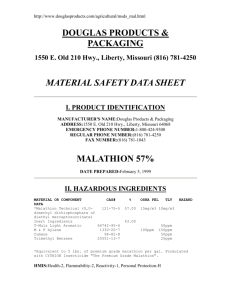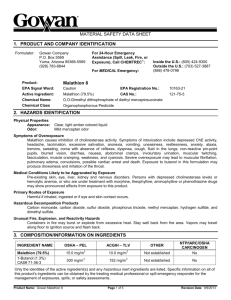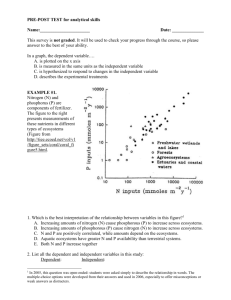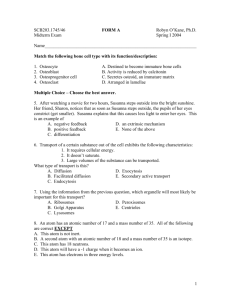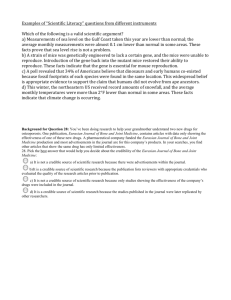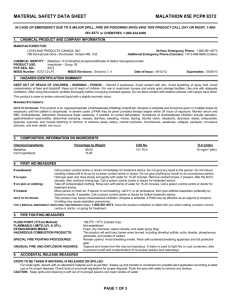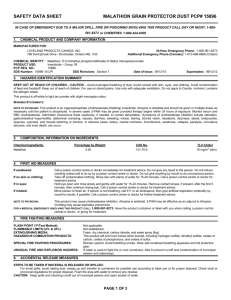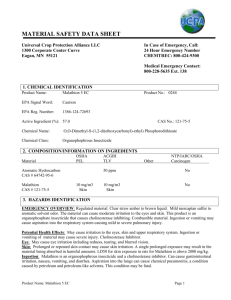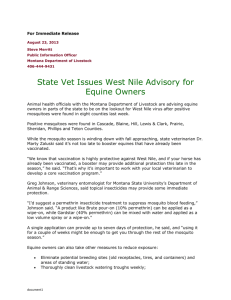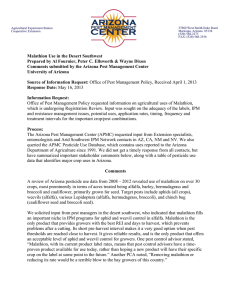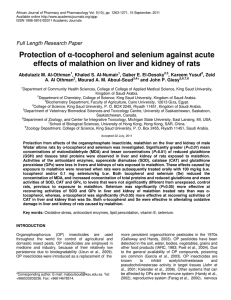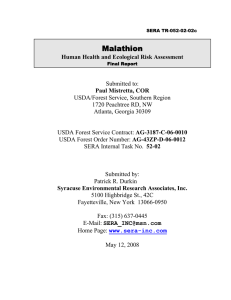Appendix A
advertisement
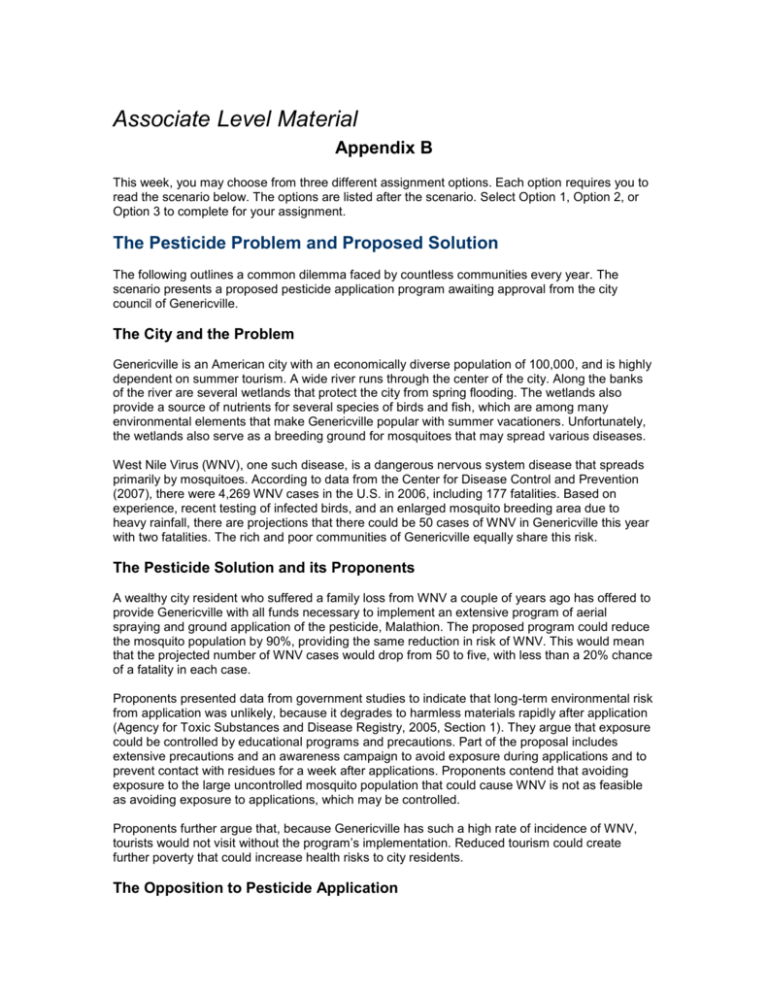
Associate Level Material Appendix B This week, you may choose from three different assignment options. Each option requires you to read the scenario below. The options are listed after the scenario. Select Option 1, Option 2, or Option 3 to complete for your assignment. The Pesticide Problem and Proposed Solution The following outlines a common dilemma faced by countless communities every year. The scenario presents a proposed pesticide application program awaiting approval from the city council of Genericville. The City and the Problem Genericville is an American city with an economically diverse population of 100,000, and is highly dependent on summer tourism. A wide river runs through the center of the city. Along the banks of the river are several wetlands that protect the city from spring flooding. The wetlands also provide a source of nutrients for several species of birds and fish, which are among many environmental elements that make Genericville popular with summer vacationers. Unfortunately, the wetlands also serve as a breeding ground for mosquitoes that may spread various diseases. West Nile Virus (WNV), one such disease, is a dangerous nervous system disease that spreads primarily by mosquitoes. According to data from the Center for Disease Control and Prevention (2007), there were 4,269 WNV cases in the U.S. in 2006, including 177 fatalities. Based on experience, recent testing of infected birds, and an enlarged mosquito breeding area due to heavy rainfall, there are projections that there could be 50 cases of WNV in Genericville this year with two fatalities. The rich and poor communities of Genericville equally share this risk. The Pesticide Solution and its Proponents A wealthy city resident who suffered a family loss from WNV a couple of years ago has offered to provide Genericville with all funds necessary to implement an extensive program of aerial spraying and ground application of the pesticide, Malathion. The proposed program could reduce the mosquito population by 90%, providing the same reduction in risk of WNV. This would mean that the projected number of WNV cases would drop from 50 to five, with less than a 20% chance of a fatality in each case. Proponents presented data from government studies to indicate that long-term environmental risk from application was unlikely, because it degrades to harmless materials rapidly after application (Agency for Toxic Substances and Disease Registry, 2005, Section 1). They argue that exposure could be controlled by educational programs and precautions. Part of the proposal includes extensive precautions and an awareness campaign to avoid exposure during applications and to prevent contact with residues for a week after applications. Proponents contend that avoiding exposure to the large uncontrolled mosquito population that could cause WNV is not as feasible as avoiding exposure to applications, which may be controlled. Proponents further argue that, because Genericville has such a high rate of incidence of WNV, tourists would not visit without the program’s implementation. Reduced tourism could create further poverty that could increase health risks to city residents. The Opposition to Pesticide Application Opponents propose that monetary resources proposed for pesticide application could be better spent on educational efforts to avoid exposure to the mosquitoes rather than on pesticide application. They argue that many people, particularly the poor or uneducated, would not follow the safety precautions required by the program. Uninformed residents, for example, could be outside during aerial spraying, or they could handle or eat matter that contains residues from application. Opponents estimate that there could be as many as 90 cases of Malathion-related illnesses from the proposed program with four that may be fatal. Opponents used information from a Florida study referenced in the same study used by proponents (Agency for Toxic Substances and Disease Registry, 2005, Section 3). Opponents also argued that the use of pesticides could kill the natural predators of mosquitoes and ultimately increase the spread of WNV and damage the fragile ecosystem important to tourism. Such long-term effects are possible and the risks are unknown. Opponents believe that, because of this unknown risk, the precautionary principle should apply to Malathion application. In other words, Malathion should not be applied until there is direct evidence that there is no longterm risk to the environment. The Decision That Is Required Like many environmental debates, stakeholders with different priorities view the same information differently. The City Council must make a decision through a majority vote. When faced with a decision, all council members have to vote. They must learn as much as they can about the options and make a decision when the time comes, even if they still have questions or do not like the alternatives. They believe that not voting or stating an unrealistic alternative is not accepting societal responsibility. What decision will you make? References Agency for Toxic Substances and Disease Registry. (2005). Toxicologic information about insecticides used for eradicating mosquitoes (West Nile Virus control). Malathion (CAS Number 121-75-5). Retrieved from http://www.atsdr.cdc.gov/consultations/west_nile_virus/ Malathion.html. Center for Disease Control and Prevention. (2007). 2006 West Nile Virus activity in the United States. West Nile Virus Statistics, Surveillance, and Control. Retrieved from http://www.cdc.gov/ncidod/dvbid/westnile/surv&controlCaseCount06_detailed.htm. Option 1: Risk Assessment Paper You are a member of the Genericville City Council. A proposal has been brought forth to use the insecticide spray. Currently, the council is split on its decision, and your vote will determine whether Malathion may be used. Create an outline of the risk of using Malathion according to the four steps of risk assessment presented in Figure 4.1 of Visualizing Environmental Science. o o o o Hazard identification Dose-response Exposure Risk characterization Decide your vote based on your outline. Write a 700- to 1,050-word paper that presents your evaluation of the risk of Malathion based on your outline. Explain the reasoning for your vote based on the four steps of risk assessment. Consider any relevant political, social, and economic aspects involved. Format your paper consistent with APA guidelines. Post your paper as an attachment. Option 2: Risk Assessment Video Presentation You are a member of the Genericville City Council. A proposal has been brought before the council to use the insecticide spray to control the mosquito population. Before a vote may occur, you have been asked to conduct a risk assessment of Malathion to present to the council. Create an outline of the risk of using Malathion according to the four steps of risk assessment presented in Figure 4.1 of Visualizing Environmental Science. o o o o Hazard identification Dose-response Exposure Risk characterization Select a position to present to the city council. Deliver a 3- to 5-minute multimedia presentation evaluating the risk of Malathion based on your outline. The presentation must be in a format that may be easily accessed and viewed by the council members. Acceptable formats or applications are Prezi®, Glogster®, Microsoft® PowerPoint®, and so forth. Explain the reasoning for your position based on the four steps of risk assessment. Consider any relevant political, social, and economic aspects involved. Be creative with this assignment. You may use props and costumes, and you may wish to enlist friends or family members. Post your file as an attachment or submit the link to your instructor. Option 3: Risk Assessment Editorial You are a columnist for the Genericville Star newspaper. A proposal has been brought before the council to use the insecticide spray to control the mosquito population. Before the council meets, you feel that the city must be aware of the proposal and its implications. Create an outline of the risk of using Malathion according to the four steps of risk assessment presented in Figure 4.1 of Visualizing Environmental Science. o o o o Hazard identification Dose-response Exposure Risk characterization Select a position to support in your editorial. Write an editorial evaluating the risk of Malathion based on your outline. Explain the reasoning for your position based on the four steps of risk assessment. Consider any relevant political, social, and economic aspects involved. Use the template provided and follow the instructions for each section. Post your editorial as an attachment. Genericville Star Articles written by: Your Name Risk Assessment of Malathion Insert text for the evaluation of the risk assessment. Summarize your assessment and consider relevant political, social, and economic aspects. The article must be between 350 and 500 words, and must fit entirely in this box. 10-point font is recommended. Delete these instructions when you are done with this section. Hazard Identification Insert text identifying if exposure to Malathion may cause an increased likelihood of adverse health effects. The story must be between 100 and 150 words, and must fit entirely in this box. 10-point font is recommended. Delete these instructions when you are done with this section. SCI/275 Dose-response assessment Insert text identifying the relationship, if any, between the amount of exposure to Malathion and the seriousness of adverse health effects. Exposure Assessment The story must be between 100 and 150 words, and must fit entirely in this box. 10-point font is recommended. Insert text identifying how much, how often, and how long are humans exposed to Malathion. Delete these instructions when you are done with this section. The story must be between 100 and 150 words, and must fit entirely in this box. 10-point font is recommended. Delete these instructions when you are done with this section. Risk Characterization Insert text identifying the probability of an individual or the population having adverse health effects to Malathion. The story must be between 100 and 150 words, and must fit entirely in this box. 10-point font is recommended. Delete these instructions when you are done with this section. SCI/275
